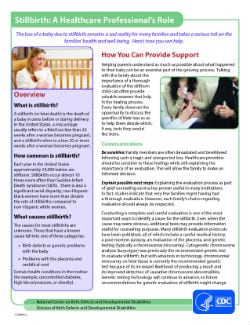Facts about Stillbirth
The loss of a baby due to stillbirth remains a sad reality for many families and takes a serious toll on families’ health and well-being. Learn more about stillbirth below.

What is stillbirth?
A stillbirth is the death or loss of a baby before or during delivery. Both miscarriage and stillbirth describe pregnancy loss, but they differ according to when the loss occurs. In the United States, a miscarriage is usually defined as loss of a baby before the 20th week of pregnancy, and a stillbirth is loss of a baby after 20 weeks of pregnancy.
Stillbirth is further classified as either early, late, or term.
- An early stillbirth is a fetal death occurring between 20 and 27 completed weeks of pregnancy.
- A late stillbirth occurs between 28 and 36 completed pregnancy weeks.
- A term stillbirth occurs between 37 or more completed pregnancy weeks..
How Many Babies Are Stillborn?
Stillbirth effects about 1% of all pregnancies, and each year about 24,000 babies are stillborn in the United States.1 That is about the same number of babies that die during the first year of life and it is more than 10 times as many deaths as the number that occur from Sudden Infant Death Syndrome (SIDS).2
Because of advances in medical technology over the last 30 years, prenatal care (medical care during pregnancy) has improved, which has dramatically reduced the number of late and term stillbirth.3 However, the rate of early stillbirth has remained about the same over time.3
What Increases the Risk of Stillbirth?
The causes of many stillbirths are unknown. Therefore, families are often left grieving without answers to their questions. Stillbirth is not a cause of death, but rather a term that means a baby’s death during the pregnancy. Some women blame themselves, but rarely are these deaths caused by something a woman did or did not do. Known contributors to stillbirth generally fall into one of three broad categories:
- Problems with the baby (birth defects or genetic problems)
- Problems with the placenta or umbilical cord (this is where the mother and baby exchange oxygen and nutrients)
- Certain conditions in the mother (for example, uncontrolled diabetes, high blood pressure, or obesity)
Stillbirth with an unknown cause is called “unexplained stillbirth.” Having an unexplained stillbirth is more likely to occur the further along a woman is in her pregnancy.

Although stillbirth occurs in families of all races, ethnicities, and income levels, and to women of all ages, some women are at higher risk for having a stillbirth. Some of the factors that increase the risk for a stillbirth include the mother:
- being of black race
- being a teenager
- being 35 years of age or older
- being unmarried
- being obese
- smoking cigarettes during pregnancy
- having certain medical conditions, such as high blood pressure or diabetes
- having multiple pregnancies
- having had a previous pregnancy loss
These factors are also associated with other poor pregnancy outcomes, such as preterm birth.
State laws require the reporting of fetal deaths, and federal law supports national collection and publication of fetal death data. The National Vital Statistics System (NVSS) released the first ever report on cause of fetal death using national data in 2016.
What can be done?
CDC works to learn more about who might have a stillbirth and why. CDC does this by tracking how often stillbirth occurs and researching what causes stillbirth and how to prevent it. Knowledge about the potential causes of stillbirth can be used to develop recommendations, policies, and services to help prevent stillbirth. While we continue to learn more about stillbirth, much work remains. To learn more about CDC’s activities, visit the Stillbirth CDC Activities page.
References
- Macdorman MF, Gregory ECW. Fetal and perinatal mortality, United States, 2013. National vital statistics reports; vol 64 no 8. Hyattsville, MD: National Center for Health Statistics. 2015. [Read report]
- Xu JQ, Kochanek KD, Murphy SL, Arias E. Mortality in the United States, 2012. NCHS data brief, no 168. Hyattsville, MD: National Center for Health Statistics. 2014. [Read report]
- MacDorman MF, Kirmeyer SE, Wilson EC. Fetal and perinatal mortality, United States, 2006. National vital statistics reports; vol 60 no 8. Hyattsville, MD: National Center for Health Statistics. 2012. [Read data brief]
New on the MedlinePlus Stillbirth page:
07/12/2018 03:42 PM EDT
Source: March of Dimes Birth Defects Foundation























.png)











No hay comentarios:
Publicar un comentario